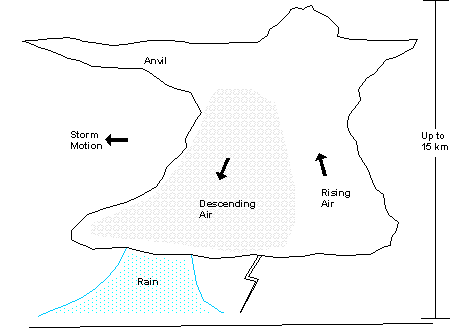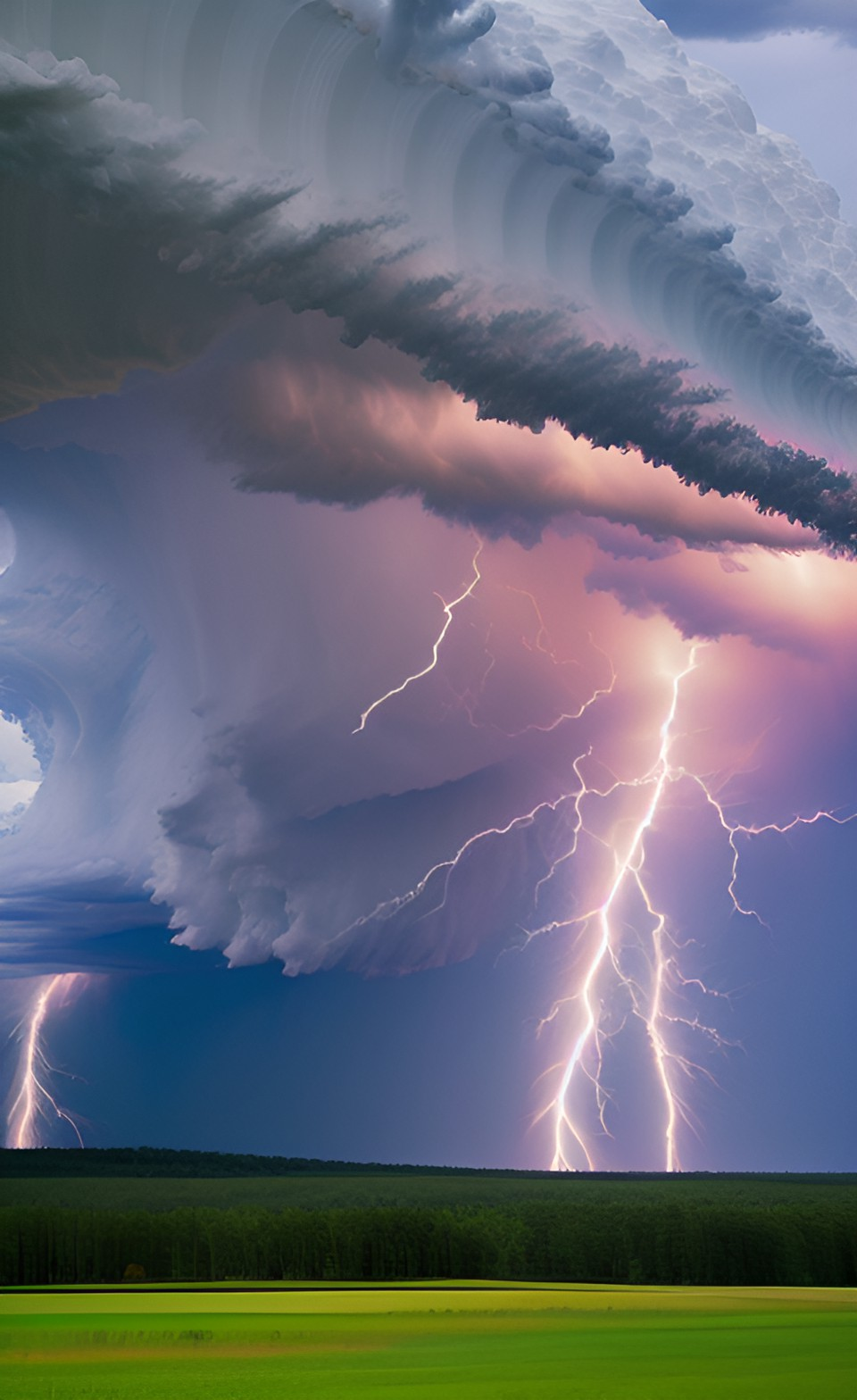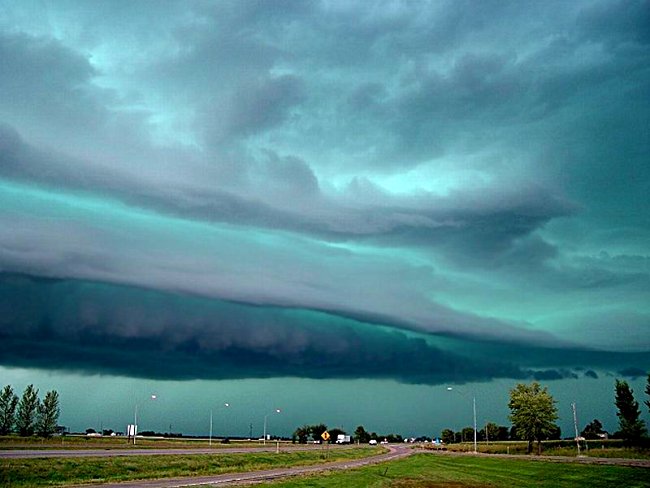- Air Homepage
- Let it Snow
- Thunderstorm Lesson Plans
Thunderstorm lesson plans - Identifying Storms
You can start your thunderstorm lesson plans with a casual introduction. Thunderstorms are familiar enough for most of us, but they still impress us.
Thunderstorm Lesson Plans for Every Teacher From the quiet build-up of moisture to the explosive power of a lightning bolt hotter than the sun, what goes into creating one of nature's most spectacular shows? Find out how to turn a puff of humid air into a full-blown thunderstorm!
Find more on weather education.
Kids love thunderstorms. Thunderstorms usually come with spectacular lightning and loud thunder that kids love. A thunderstorm's strong winds and rain can also mesmerize them. At least they did when I was young.
What causes thunderstorms? Condensation forms in an unstable atmosphere, releasing energy. As a result, the air warms up and rises quickly, which often combines with moisture that evaporates.
The convergence of high temperature and humidity with a lifting mechanism, like a cold front, takes the thunderstorm to its mature stage. At this point, most people recognize a thunderstorm.
You can start your thunderstorm lesson plans with a casual introduction. Thunderstorms are familiar enough for most of us, but they still impress us.
Here's what I mean in seven easy steps
- Instability in the atmosphere: Thunderstorms usually form when the atmosphere is unstable. This means there's a big vertical temperature gradient, a sudden change where warm, moist air exists under cooler air aloft. Strong upward air currents are set up by the instability.
- Evaporation and moisture are crucial for thunderstorm formation. When the sun heats up the Earth's surface, water evaporates from water bodies, soil, and vegetation. It's warm, moist air that carries moisture up.
- Warm, moist air rises when it encounters a low pressure area or a trigger mechanism like a front. Air rising creates an updraft, lifting moisture higher into the atmosphere. Condensation happens when air expands and cools as it rises.
- When moist air rises, the water vapor within it condenses into tiny water droplets or ice crystals as it cools, releasing heat which drives the air further upward. Thunderstorms start with towering cumulus clouds, which are made up of droplets and crystals.
- Thunderstorm development: Within the cumulus cloud that has now formed, the upward motion of air continues. As the air rises and cools, water droplets can freeze, forming ice particles as they freeze. It releases even more latent heat, which fuels stronger updrafts and intensifies the storm.
- Lightning: Strong updrafts and collisions between ice particles and water droplets within a storm cloud separate the positive and negative electrical charges. As a result of this charge separation, lightning forms, which is when electrical energy is discharged between different parts of the cloud or between the cloud and the ground.
- Thunder is caused by the rapid expansion and contraction of air surrounding the lightning channel, which produces shock waves. Additionally, raindrops and ice particles grow inside storm clouds because of the upward motion of air. As these particles get heavier, the updrafts can't support them, so they fall to the ground as precipitation, like rain, hail, or snow.
Storm-o-genesis: Another way of putting it
Have a look at these thunderstorm pictures.
Let's start with some basics about thunderstorms. There are three stages to a thunderstorm. Let's learn about them now. Water vapour drafts rise into the atmosphere during the cumulus stage of a thunder storm.
Due to adiabatic expansion (an increase in size with no heat flowing into the air), we have rapid cooling. Moisture condenses into liquid droplets to form cumulonimbus clouds.
The casual observer doesn't yet see a storm coming. You can include hints, lightning, and thunderstorm information in your thunderstorm lesson plans so students can identify embryonic storms. Here's some lightning in slowmotion:
When a thunderstorm matures, the warm air rises until it finds warmer ambient air. For more severe thunderstorms, it rises even higher.
Near the top of a thunderstorm, the rising air hits a cap (inversion) and spreads out like housefire hitting a flat ceiling, and then gets stretched out by speedy winds aloft into the distinctive anvil shape.
The updraft/cooling causes water droplets to freeze, which may turn back into liquid turning into hard rain. Sometimes hail or tornadoes happen because of increasingly complex wind patterns.
Lightning is created when a charge builds up within thunderstorm clouds. Despite being extremely brief, the temperature for a lightning bolt can actually get hotter than the surface of the sun when the charge is released.
The sound of thunder is made when heat is released, causing rapid air expansion and molecular collisions. You can find out how far away the lightning was by counting the seconds between seeing the lightning and hearing the thunder. To get the distance in miles, multiply that number by five (or three for kilometres).
Finally, in the third stage, a down draft takes over and pushes down, dissipating the thunderstorm. Cool air cuts the rising warm air and ends the updraft, killing the storm.
Additional thunderstorm lesson plans
Show how thunderstorms happen all over the world. Some places in the tropics have rainy seasons with intense thunderstorms every day. I'll give you an example.
Kampala, in Uganda, is known for having the loudest thunder on earth. There are also storms in countries that have monsoon seasons and places that get typhoons and hurricanes.
In other regions, like the American Midwest, thunderstorms usually hit in the spring and summer, when rising temperatures meet cold fronts coming from over the mountains.
Researchers have been learning more about thunderstorms, which are part of the natural world. You could include these developments in your thunderstorm lesson plans.
Thunderstorm formation is a complex process influenced by a lot of factors. To improve weather forecasting and learn more about severe weather, scientists study and refine their understanding of thunderstorms.
For more in-depth information, you can check with your local meteorological society or library. See http://www.weatheroffice.pyr.ec.gc.ca/skywatchers/teachersGuide/tg_chap04_e.html for some additional storm guidance and safety info.
Go back from Thunderstorm Lesson Plans to the
Snow Wallpaper web page now.
Search this site for more information now.
Severe Weather Lesson Plans - Teach Your Students About Thunderstorms
Are you planning to offer a few classes on weather? Are you looking for thunderstorm lesson plans? Here are a few ideas for your lessons on airborne objects.
Do you have concerns about air pollution in your area??
Perhaps modelling air pollution will provide the answers to your question.
That is what I do on a full-time basis. Find out if it is necessary for your project.
Have your Say...
on the StuffintheAir facebook page
Other topics listed in these guides:
The Stuff-in-the-Air Site Map
And,
Thank you to my research and writing assistants, ChatGPT and WordTune, as well as Wombo and others for the images.
OpenAI's large-scale language generation model (and others provided by Google and Meta), helped generate this text. As soon as draft language is generated, the author reviews, edits, and revises it to their own liking and is responsible for the content.





New! Comments
Do you like what you see here? Please let us know in the box below.